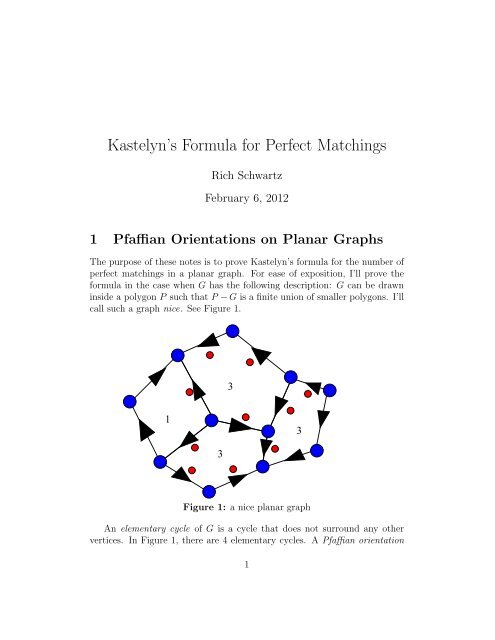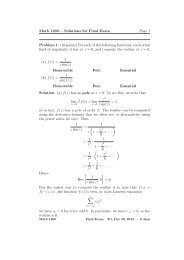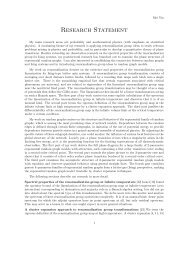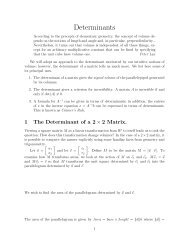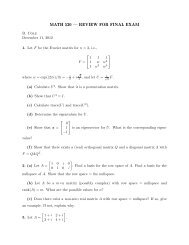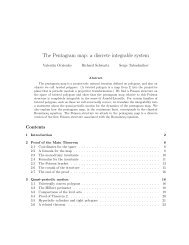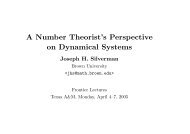Kastelyn's Formula for Perfect Matchings
Kastelyn's Formula for Perfect Matchings
Kastelyn's Formula for Perfect Matchings
You also want an ePaper? Increase the reach of your titles
YUMPU automatically turns print PDFs into web optimized ePapers that Google loves.
Kastelyn’s <strong>Formula</strong> <strong>for</strong> <strong>Perfect</strong> <strong>Matchings</strong><br />
Rich Schwartz<br />
February 6, 2012<br />
1 Pfaffian Orientations on Planar Graphs<br />
The purpose of these notes is to prove Kastelyn’s <strong>for</strong>mula <strong>for</strong> the number of<br />
perfect matchings in a planar graph. For ease of exposition, I’ll prove the<br />
<strong>for</strong>mula in the case when G has the following description: G can be drawn<br />
inside a polygon P such that P −G is a finite union of smaller polygons. I’ll<br />
call such a graph nice. See Figure 1.<br />
1<br />
3<br />
3<br />
Figure 1: a nice planar graph<br />
An elementary cycle of G is a cycle that does not surround any other<br />
vertices. In Figure 1, there are 4 elementary cycles. A Pfaffian orientation<br />
1<br />
3
on G is a choice of orientations <strong>for</strong> each edge such that there are an odd number<br />
of clockwise edges on each elementary cycle. Figure 1 shows a Pfaffian<br />
orientation. The red dots indicate the clockwise edges, with respect to each<br />
elementary cycle.<br />
Lemma 1.1 Any nice graph has a Pfaffian orientation.<br />
Proof: Choose a spanning tree T <strong>for</strong> G and orient the edges of T arbitrarily.<br />
Define a dual graph as follows. Place one vertex in the interior of each<br />
elementary cycle of G, and a root vertex <strong>for</strong> the outside of the big polygon,<br />
and then connect the vertices by an edge if they cross an edge not in T. Call<br />
this dual graph T ∗ . If T ∗ is not connected, then T contains a cycle. Since<br />
T contains a cycle, T ∗ is connected. If T ∗ contains a cycle, then T is not<br />
connected. Since T is connected, T ∗ contains no cycle. In short T ∗ is a tree.<br />
Let v be any node of T ∗ . The vertex v joins to an edge w of T ∗ across an<br />
edge e ∗ . The edge e ∗ crosses one edge e of the corresponding elementary cycle<br />
of G. Orient e so that this cycle has an odd number of clockwise oriented<br />
edges, then cross off v and e ∗ , leaving a smaller tree. Now repeat, using a<br />
node of the smaller tree. And so on. At each step, there is one way to orient<br />
the edge to make things work <strong>for</strong> the current elementary cycle. ♠<br />
Figure 2: the trees T and T ∗ .<br />
2
2 Kastelyn’s Theorem<br />
Let G be a nice graph with a Pfaffian orientation. Assume that G has an<br />
even number of vertices. Let v1,...,v2n be the vertices of G. Let A denote<br />
the signed adjacency matrix of G. This means that<br />
• Aij = 0 if no edge joins vi to vj.<br />
• Aij = 1 if the edge joining vi to vj is oriented from vi to vj.<br />
• Aij = −1 if the edge joining vi to vj is oriented from vj to vi.<br />
A perfect matching of G is a collection of edges e1,...,en of G such that<br />
every vertex belongs to exactly one ej. Let P(G) denote the number of<br />
distinct perfect matchings of G. These notes are devoted to proving:<br />
Theorem 2.1 (Kastelyn) P(G) =<br />
�<br />
|det(A)|.<br />
Let A t denote the transpose of a matrix A. The matrix A is called skewsymmetric<br />
if A t = −A. This is equivalent to the condition Aij = −Aji <strong>for</strong><br />
all i,j. By construction, the signed adjacency matrix A is skew-symmetric.<br />
Let A be a 2n×2n skew symmetric matrix. The Pfaffian of A is defined<br />
as the sum<br />
p(A) = 1<br />
2 n n!<br />
� n�<br />
sign(σ) Aσ(2i−1),σ(2i). (1)<br />
σ i=1<br />
The sum is taken over all permutations of the set {1,...,2n}.<br />
Below, we’ll prove the following result, known as Muir’s Identity.<br />
(p(A)) 2 = det(A). (2)<br />
GivenMuir’sIdentity,Kastelyn’sTheoremcanbere<strong>for</strong>mulatedasfollows.<br />
Theorem 2.2 Let G be a nice graph, equipped with any Pfaffian orientation.<br />
Let A be the corresponding signed adjacency matrix. Then P(G) = |p(A)|.<br />
First I’ll prove Theorem 2.2 and then I’ll derive Muir’s Identity.<br />
3
3 Proof Theorem 2.2<br />
Given that A is a skew-symmetric matrix, there is some redundancy in the<br />
definition of the Pfaffian. We write our permutations as<br />
(1,...,2n) → (i1,j1,i2,j2,...,in,jn). (3)<br />
Say that two permutations are equivalent if one can get from one to the<br />
other by permuting the (i,j) pairs and/or switching elements within the<br />
pairs. Each equivalence class of permutations has 2 n n! members. Moreover,<br />
each equivalence class has a unique member such that i1 < ... < in and<br />
ik < jk <strong>for</strong> all k. Let S denote the set of these special permutations.<br />
Two equivalent permutations contribute the same term in p(A), thanks<br />
to the skew symmetry of A. There<strong>for</strong>e, we have the alternate definition<br />
p(A) = � n�<br />
sign(σ) Aσ(2i−1),σ(2i). (4)<br />
σ∈S i=1<br />
The terms in Equation 4 are in one-to-one correspondence with the perfect<br />
matchings. To prove Theorem 2.2, we just have to prove that all such<br />
terms have the same sign. Let s(M) be the term of Equation 4 corresponding<br />
to the perfect matching M. We orient the edges of M according to the<br />
Pfaffian orientation. Call an edge of M bad if it points from a higher indexed<br />
vertextoalowerindexedvertex. Thesignofs(M)justdependsontheparity<br />
of the number of bad edges. We just have to prove that every two perfect<br />
matchings M1 and M2 have the same parity of bad edges.<br />
The symmetric difference M1∆M2 is a finite union of (alternating) cycles<br />
of even length. We can produce a new perfect matching M ′ by switching the<br />
matching on one or more of the cycles of M1∆M2. Thus, M1 and M2 can<br />
be “joined” by a chain of perfect matchings, each of which differ by a single<br />
even alternating cycle. Hence, it suffices to consider the case when M1∆M2<br />
is a single cycle C.<br />
If we permute the indices of G and recompute the signs, all permutations<br />
change by the same global sign. So, it suffices to consider the case when the<br />
vertices of C are given as 1,...,2k in counterclockwise order. The edges of<br />
M1|C are (12), (34), etc. so the bad edges of M1|C are precisely the clockwise<br />
edges. If M1|C has an odd (even) number of bad edges then M1|C has an<br />
odd (even) number of clockwise edges. The edges of M2|C are (23), (45), ...,<br />
(k1). Hence, if M2|C has an odd (even) number of bad edges then M2|C has<br />
an even (odd) number of clockwise edges.<br />
4
The cycle C surrounds some edges common to M1 and M2. There<strong>for</strong>e C<br />
surrounds an even number of vertices. Below we will prove that C must have<br />
an odd number of clockwise edges. Hence, the number of clockwise edges in<br />
the two cases has opposite parity. Hence, the number of bad edges in the<br />
two cases has the same parity. Hence s(M1) = s(M2).<br />
The following Lemma completes the proof of Theorem 2.2.<br />
Lemma 3.1 (Kastelyn) Suppose that C is a cycle that surrounds an even<br />
number of vertices. Then C has an odd number of clockwise edges.<br />
Proof: Let n(C) denote the number of clockwise edges of C plus the number<br />
of vertices contained in the interior of the region bounded by C. It suffices<br />
to prove that n(C) is always odd.<br />
Every nice planar graph G ′ can be extended to a triangulated disk G,<br />
and every Pfaffian orientation on G ′ extends to a Pfaffian orientation on G.<br />
(When each new edge is drawn, breaking up an elementary cycle, there is a<br />
unique way to orient the edge to keep the condition on the two smaller cycles<br />
that are created.) So, it suffices to prove this result when C is the boundary<br />
of a triangulated disk ∆.<br />
There are two cases to consider, Suppose ∆ has an interior edge e which<br />
joins two vertices of C. Then we can write ∆ = ∆1 ∪∆2, where ∆1 and ∆2<br />
are two smaller disks joined along e. Let Cj be the boundary of ∆j. Here<br />
we have n(C)−1 = n(C1)+n(C2) because e is counted exactly once on the<br />
right hand side. In this case, we see by induction that n(C) is odd.<br />
The remaining case to consider is when ∆ has a triangle T having an<br />
edge on C and one interior vertex, as shown in Figure 3. In this case, let and<br />
∆ ′ = ∆ −T. Let C ′ be the boundary of ∆ ′ . A short case by case analysis<br />
shows that N(C) = N(C ′ ) or N(C) = N(C ′ )−2. The result again holds by<br />
induction. ♠<br />
T<br />
Figure 3: Chopping off a triangle<br />
5
4 Muir’s Identity<br />
The remainder of these notes is devoted to proving Muir’s Identity.<br />
Call the matrix A special if it has the <strong>for</strong>m<br />
⎡<br />
⎤<br />
M1 0 ... 0 0 0<br />
⎢ 0 M2 0 ... 0 0 ⎥<br />
A = ⎢<br />
⎥<br />
⎣ 0 0 M3 0 ... 0⎦<br />
...<br />
, Mk<br />
�<br />
0<br />
=<br />
−ak<br />
�<br />
ak<br />
0<br />
From Equation 4 we have p(A) = a1...an. Also det(A) = (a1...an) 2 . So,<br />
Muir’s identity holds when A is a special matrix.<br />
Below we will prove<br />
Lemma 4.1 Let X denote the set of all 2n×2n skew symmetric matrices.<br />
There is an open S ⊂ X with the following property. If A ∈ S then there is<br />
a rotation B (depending on A) such that BAB −1 is a special matrix.<br />
After we prove Lemma 4.1, we will establish the following trans<strong>for</strong>mation<br />
law. If B is any 2n×2n matrix, then<br />
(5)<br />
p(BAB t ) = det(B)p(A). (6)<br />
Let A ∈ S, the set from Lemma 4.1. We have<br />
(p(A) 2 ) = 1 (p(BAB −1 )) 2 = 2 det(BAB −1 ) = 3 det(A).<br />
Equality 1 comes from the Equation 6 and from the fact that B t = B −1<br />
when B is a rotation. Equality 2 is Muir’s identity <strong>for</strong> special matrices.<br />
Equality 3 is a familiar fact about determinants. Since Muir’s identity is a<br />
polynomialidentity,andholdsonanopensubsetofskew-symmetricmatrices,<br />
the identity holds <strong>for</strong> all skew-symmetric matrices.<br />
5 Proof of Lemma 4.1<br />
The best way to do this is to work over the complex numbers, and then drop<br />
back down to the reals at the end.<br />
Let 〈,〉 be the standard Hermitian <strong>for</strong>m on C 2n . That is<br />
〈(z1,...,z2n),(w1,...,w2n)〉 =<br />
6<br />
2n�<br />
i=1<br />
ziwi. (7)
Here, the bar denotes complex conjugation. Here are some basic properties<br />
of this object.<br />
• When v,w ∈ R 2n , we have 〈v,w〉 = v · w. So, the Hermitian <strong>for</strong>m is<br />
kind of an enhancement of the dot product.<br />
• 〈v,w〉 = 〈v,w〉.<br />
• 〈av1 +v2,w〉 = a〈v1,w〉+〈v2,w〉.<br />
• LetM ∗ denotetheconjugatetransposeofM. Then〈Mv,w〉 = 〈v,M ∗ w〉.<br />
These properties will be used in the next lemma.<br />
Lemma 5.1 If A is real and skew symmetric (so that A ∗ = −A) then the<br />
eigenvalues of A are pure imaginary.<br />
Proof: Let λ be an eigenvalue and v a corresponding eigenvector. We have<br />
λ〈v,v〉 = 〈Av,v〉 = 〈v,A ∗ v〉 = 〈v,−λv〉 = −λ〈v,v〉. (8)<br />
Hence λ = −λ. This is only possible if λ is pure imaginary. ♠<br />
Let S denote the set of real skew-symmetric matrices having eigenvalues<br />
of the <strong>for</strong>m λ1,λ1,...,λn,λn, where 0 < |λ1| < ... < |λn|. Note that S is<br />
nonempty, because one can easily construct a special matrix in S. Note also<br />
that S is open, because the eigenvalues vary continuously. So, S contains a<br />
nonempty open set.<br />
Let A be any element of S. Let Ek ⊂ C 2n denote the subspace of vectors<br />
of the <strong>for</strong>m av+bw where A(v) = λk(v) and B(w) = λk(w). By construction,<br />
Ek is a 2-dimensional subspace over C.<br />
Lemma 5.2 Suppose i �= j. If v ∈ Ei and w ∈ Ej then 〈v,w〉 = 0.<br />
Proof: It suffices to prove that 〈v1,v2〉 = 0 when v1 and v2 are eigenvalues<br />
of A corresponding to eigenvalues having different magnitudes. We have<br />
λ1〈v1,v2〉 = 〈A(v1),v2〉 = 〈v1,A ∗ (v2)〉 = −〈v1,A(v2)〉 = −λ2〈v1,v2〉.<br />
Hence, either |λ1| = |λ2| or 〈v1,v2〉 = 0. ♠<br />
Let Vk = Ek ∩R 2n .<br />
7
Lemma 5.3 Vk is 2-dimensional as a real vector space.<br />
Proof: Note that Ek is invariant under complex conjugation. Vk is at least 2<br />
dimensional because it contains all vectors of the <strong>for</strong>m v+v with v ∈ Ek. On<br />
the other hand Vk cannot be more than 2-dimensional because the C-span<br />
of Vk is contained in Ek. ♠<br />
For real vectors v,w, recall that 〈v,w〉 is just the dot product. Hence<br />
v · w = 0 when v ∈ Vi and w ∈ Vj. So the n planes V1,...,Vn are pairwise<br />
perpendicular. Note also that A(Vk) = Vk. So, we have succeeded in finding<br />
n pairwise perpendicular and A-invariant 2-planes in R 2n .<br />
Lemma 5.4 A acts on each Vk as a dilation by |λk| followed by a 90 degree<br />
rotation.<br />
Proof: Note that A 2 has all negative real eigenvalues. On Ek, we have<br />
A 2 (v) = −|λk| 2 (v). The lemma follows immediately from this. ♠<br />
Now <strong>for</strong> the end of the proof: Given the properties of V1,...,Vn, we can<br />
find a rotation B such that<br />
B(Vk) = Wk := span(e2k−1,e2k), k = 1,...,n. (9)<br />
The map BAB −1 preserves Wk and acts on Wk as the composition of a<br />
dilation and a 90 degree rotation. From here, it is easy to see that BAB −1<br />
must be a special matrix.<br />
6 The Trans<strong>for</strong>mation Law<br />
6.1 Brute Force Approach<br />
By an obvious scaling argument, it suffices to establis Step 1 when det(B) =<br />
1. As is well known from Gaussian elimination, every such B is the product<br />
of elementary matrices. Using the fact that det(E1E2) = det(E1)det(E2), it<br />
suffices to establish Step 1 <strong>for</strong> elementary calculations. This is a fairly easy<br />
calculation which you might prefer to the more abstract argument given<br />
below.<br />
8
6.2 The Main Argument<br />
Let V = R 2n and let V ∗ denote the dual space. Let e1 ,...,e 2n denote the<br />
standard basis <strong>for</strong> V ∗ .<br />
Given the skew-symmetric matrix A, introduce the 2-<strong>for</strong>m<br />
[A] = �<br />
i
6.3 Forms<br />
Now I’ll give details on tensors which should explain the argument above.<br />
Let V = R 2n . Let V ∗ denote the vector space of linear functions from V<br />
to R. The space V ∗ is called the dual of V. A canonical basis <strong>for</strong> V ∗ is given<br />
by e 1 ,...,e 2n , where e j is the function such that<br />
A k-tensor is a map φ : V ×...×V → R such that<br />
e j (a1,...,a2n) = aj. (14)<br />
φ(∗,...,∗,av+w,∗,...,∗) = aφ(∗,...,∗,v,∗,...,∗)+φ(∗,...,∗,w,∗,...,∗). (15)<br />
In other words, if you hold all positions fixed but one, then φ is a linear<br />
function of the remaining variable. The product V ×...×V is supposed to<br />
be the k-fold product.<br />
The k-tensor φ is said to be a k-<strong>for</strong>m if<br />
φ(∗,...,∗,ai,∗,...,∗,aj,∗,...,∗) = −φ(∗,...,∗,aj,∗,...,∗,ai,∗,...,∗). (16)<br />
In other words, if you switch two of the entries, the sign changes.<br />
If φ1 and φ2 are k-<strong>for</strong>ms, then so are rφ1 and φ1+φ2. In other words, the<br />
set of all k-<strong>for</strong>ms makes a vector space. This vector space is denoted ∧ k (V).<br />
A nice element of ∧ k (V) is given by<br />
ω = e i1 ∧...∧e ik , i1 < ... < ik. (17)<br />
This tensor has the following description. If we want to evaluate ω(v1,...,vk),<br />
we make a 2n × k matrix having rows v1,...,vk. Then we take the square<br />
minor made from columns i1,...,ik, then we take the determinant of this<br />
minor. Familiar properties of the determinant guarantee that ω really is a<br />
k-<strong>for</strong>m. Call ω an elementary k-<strong>for</strong>m.<br />
Lemma 6.2 The elementary k-<strong>for</strong>ms make a basis <strong>for</strong> ∧ k (V).<br />
Proof: Anyk-<strong>for</strong>misdeterminedbywhatitdoestothek-tuples(ei1,...,eik ),<br />
as the indices range over all possibilities. Hence, the elementary <strong>for</strong>ms span<br />
∧k (V). Also, the <strong>for</strong>m ei1 ik ∧...∧e assigns 1 to (ei1,...,eik ) and 0 to all other<br />
such lists. Hence this particular elementary k-<strong>for</strong>m is not a linear combination<br />
of the others. But this means that the elementary k-<strong>for</strong>ms are linearly<br />
independent. ♠<br />
10
6.4 The Wedge Product<br />
Now we know that ∧ k (V) has dimension 2n choose k. In particular, ∧ 2n (V)<br />
has dimension 1: all 2n-<strong>for</strong>ms are multiples of e 1 ∧...∧e 2n .<br />
Given two lists I = {i1 < ... < ia} and J = {j1 < ... < jb}, let K denote<br />
the sorted list of I ∪J. We define<br />
• σ(I,J) = 0 if I ∩J �= ∅.<br />
• σ(I,J) = 1 if an even permutation sorts the elements i1,...,ia,j1,...,jb.<br />
• σ(I,J) = −1ifanoddpermutationsortstheelementsi1,...,ia,j1,...,jb.<br />
There is a bi-linear map<br />
defined as follows.<br />
∧ : ∧ a (V)×∧ b (V) (18)<br />
(e i1 ∧...∧e ia )∧(e j1 ∧...∧e jb ) = σ(I,J)e k1 ∧...∧e ka+b . (19)<br />
The map is extended to all of ∧ a (V) × ∧ b (V) using bi-linearity. This map<br />
is known as the wedge product. The wedge product is associative, so that<br />
(α∧β)∧γ = α∧(β ∧γ).<br />
Another <strong>for</strong>mula <strong>for</strong> the wedge product is<br />
α∧β(v1,...,va,wa+1,...,wa+b) =<br />
1 �<br />
sign(σ)α(vσ(1),...,vσ(a))×β(wσ(a1),...,wσ(a+b)) (20)<br />
(a+b)! σ<br />
The sum is over all permutations of the set 1,...,a + b. The (×) in this<br />
equation is just ordinary multiplication. One can check, using properties of<br />
determinants, that this <strong>for</strong>mula holds when α and β are elementary <strong>for</strong>ms.<br />
Then, the general case follows from the linearity of Equation 20.<br />
As in the short version of Step 1, we define [A] ∈ ∧2 (V) to be the 2-<strong>for</strong>m<br />
[A] = �<br />
i
6.5 Trans<strong>for</strong>mation Laws<br />
Nothing we say here has to do with the dimension being even, so we set<br />
m = 2n and remark that everything works <strong>for</strong> m odd as well. Suppose that<br />
T is a linear trans<strong>for</strong>mation and ω is a k-<strong>for</strong>m. We have the general definition<br />
As a special example, we have<br />
T ∗ (ω)(v1,...,vk) = ω(T(v1),...,T(vk)). (22)<br />
T ∗ (e 1 ∧...∧e m )(e1,...,em) = e 1 ∧...∧e m (T(e1,...,t(2m)) =<br />
� �<br />
σ<br />
e 1 ∧...∧e m<br />
�<br />
�<br />
T1jej,..., �<br />
�<br />
Tnjej =<br />
sign(σ) �<br />
�<br />
Ti,σ(i) e 1 ∧...∧e m = det(T)e 1 ∧...∧e m .<br />
The sum is taken over all permutations. Since ∧ m (V) is 1-dimensional,<br />
and the pull back operation respects scaling, we have the simpler <strong>for</strong>mula<br />
T ∗ (ω) = det(T)ω, (23)<br />
<strong>for</strong> any m-<strong>for</strong>m. This explains Equality 1 in Equation 13.<br />
It is an easy consequence of Equation 20 that<br />
T ∗ (α∧β) = T ∗ (α)∧T ∗ (β). (24)<br />
From the associativity of the wedge product, we get<br />
T ∗ (α1 ∧...∧αk) = T ∗ (α1)∧...∧T ∗ (αk). (25)<br />
This explains Equality 2 in Equation 13.<br />
12


